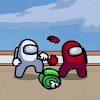Color swatches are useful for conventional art, but they aren't required for digital paintings. Using just Layer Blend Modes, you can generate stunning shading. I believe this post has shown Photoshop's extraordinary adaptability. Even if your technique isn't so advanced, you can always rely on it to make the job lot simpler.
Meshing of Gradients
Gradient meshing is one of the methods to use if you want hyper-realistic skin shading with no evidence of form stacking. It's one of those methods that may result in beautiful skin but can be difficult to master. You can produce realistic skintones and shading by properly utilizing the Eyedropper Tool with a reference picture, which may frequently seem like a copied photograph rather than a vector design.
First, I'll choose a color similar to the primary fill color. I'll next deepen that color and apply it evenly to the whole layer using a wide pen brush to create a foundation color. Following that, I'll go over each part and color the lines to match the surrounding region. The red of the crest, for example, and the blue of the eyes would be utilized as a basis to color the surrounding lines. That's basically how it's done!
We looked at how ellipses help us comprehend the fundamental volume of geometric forms in the last episode, and now we're utilizing them to better understand the contours of the face. Because the face is not flat, this will aid with shading and understanding the 3D aspect of the face. When sketching the face, we must examine where the face bends, dips, folds, and so on. Eyelids wrap around the eye as Lips wrap around the mouth; they respond to the curve and have volume to them. Furthermore, eyeballs are like balls attached to a pole; they move in unison.












